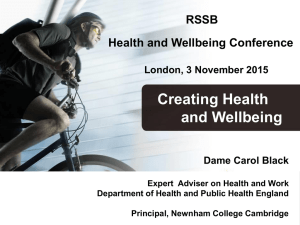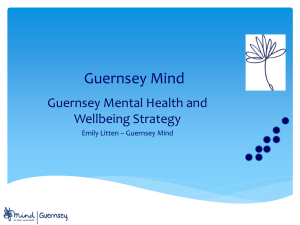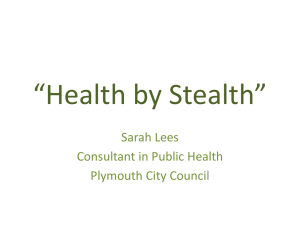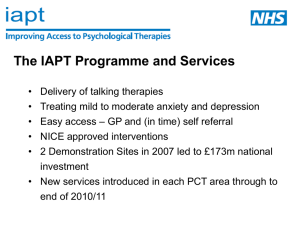The role of universities in promoting healthy workplaces
advertisement
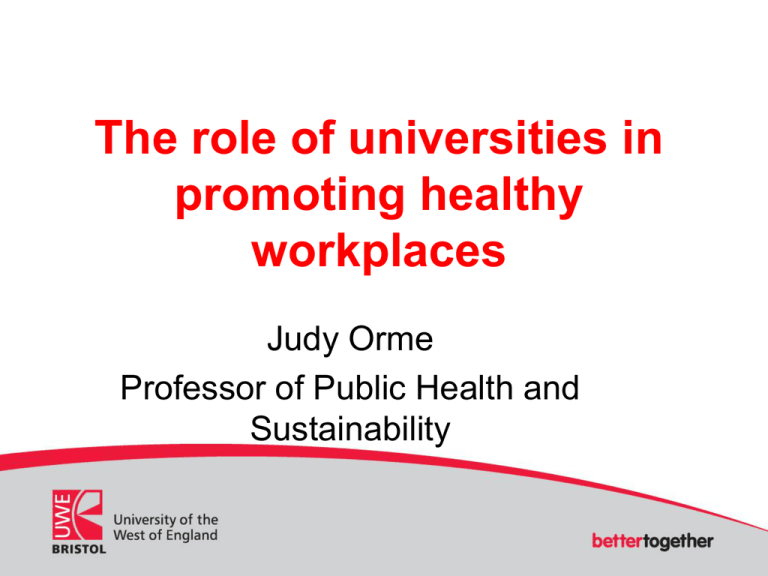
The role of universities in promoting healthy workplaces Judy Orme Professor of Public Health and Sustainability A Settings Approach • Ottawa Charter (WHO, 1986) “Health is created and lived by people within the settings of their everyday life; where they learn, work, play and love.” • Settings approach – starting point for health promotion programmes: “…shifting the focus from the deficit model of disease to the health potentials inherent in the social and institutional settings of everyday life”. (Kickbusch 1996) Healthy settings approach • A settings approach advocated since mid 80s. • Socio- ecological model of health • Dynamic complex systems • Whole system thinking • Examples – schools, universities, hospitals, sports stadia, workplace, cities. Determinants of health and well-being Health Map - Barton, H. and Grant, M. downloadable under a creative commons licence from www.bne.uwe.ac.uk/who/health map/ccl.asp Obesity – perhaps not quite so simple! – Foresight obesity causal map 5 Policy context ‘Working for a Healthier Tomorrow’ (Black, 2008) • ‘Improving Health and Work’ - The Government’s Response (2008) • ‘NHS Health and Well-Being Review’ (Boorman, 2009) This report found that NHS organisations that prioritise staff health and wellbeing performed better, in terms of quality, patient satisfaction, staff retention and sickness absence. Working for a healthier tomorrow 3 principal objectives •Prevention of illness and promotion of health and wellbeing •Early intervention for those who develop a health condition •An improvement in the health of those out of work Public health & public health economics • PH Outcomes Framework 2012 • Mental health problems and Musculoskeletal disorders are major causes of sickness absence • Lifestyle behaviours – smoking + obesity • 175 million working days lost to illness in 2006 • Annual economic costs of working age illhealth estimated over £100 billion • SROI type calculations e.g. £1 invested in workplace health brings a return of £3.50 Government response • Creating new perspectives on health and work e.g.Fit note; GP education; Regional coordinators; Evidence base • Improving work and workplaces e.g. NHS workforce review; OH helpline; National strategy for Mental health & employment • Supporting people to work e.g. Fit for Work pilots Active Workplace Initiative Rochdale Council 2006-10 Year Average sick days per employee Cost of sickness absence Reduction in sickness costs 2006/07 11.3 £10.57 million N/A 2007/08 10.6 £9.91million £660 k 2008/09 10.0 £9.35 million £560 k 2009/10 9.4 £8.79 million £560 k Total £38.62 million £1.78 million Employer benefit evidence • Royal Mail – health & wellbeing initiatives • British Gas – back care workshops • Parcelforce – comprehensive wellbeing programme • SMEs? Developing Leadership and Governance for Healthy Universities • 169 HEIs • 2.4m students • 370,000 staff Wellbeing & engagement In UK HE sector: • £270m cost of sickness absence per year • 10% reduction in average sickness absence = £27m per year (e.g. £400K for Univ of Sheffield) • If a 10% increase in performance is worth minimum of 5% of salary (£1,606 per employee) £600m potential financial gain per year(e.g.£9.6m per year to Univ Bristol) 7 Government indicators 1. Improving knowledge about the importance of work health + health work. 2. Improving the promotion of health & well-being 3. Reducing the incidence of work-related ill-health and injuries and their causes. 4. Reducing proportion of people out of work due to ill-health. 5. Improving self-reported health status 6. Improving access to health service support. 7. Improving business productivity Public Health Responsibility Deal – Health@work pledges • Occupational health standards • Health and wellbeing reporting • Chronic conditions guide • Healthier staff restaurants Higher Education Sector Project findings-health & wellbeing Projects: • Leadership and Governance of Healthy Universities (HEFCE) • Improving performance through wellbeing & engagement (HEFCE) Healthy Universities “A Healthy University aspires to create a learning environment and organisational culture that enhances the health, well-being and sustainability of its community and enables people to achieve their full potential.” www.healthyuniversities.ac.uk Healthy Universities Examples of Integrative Work Transport: sustainable transport policies are increasingly being developed and championed across higher education sector, contributing to action on climate change by reducing carbon emissions and helping tackle obesity and other chronic diseases by promoting physical activity. Food: ‘whole university’ healthy and sustainable food frameworks can also impact positively on health and carbon reduction, helping to address interconnected procurement, catering, retail, education, research and advocacy roles in an integrated way. Curriculum: universities can also embed health and sustainable development into their core business through means of curriculum development linked to research and knowledge exchange – with an emphasis on inter-disciplinary transformative learning. Orme and Dooris, 2010 Back Case study Healthy and Sustainable Food @ UWE Date added: 8th November 2010 Author: Peter Cockburn and Judy Orme Organisation: University of the West of England Case Study Summary Food is an issue that clearly highlights the interconnectedness of health and sustainable development agendas. UWE have developed a whole-system approach ensuring that they focus on multi-pronged aspects of food and health including procurement, catering, retail, education and research. This case study highlights what has been achieved, what is still to do and the challenges a comprehensive food and health strategy presents for universities. Resources Related Guidance Package: Communicating Health Messages as Part of a Whole System Healthy Universities Approach Back Case study Active Travel Date added: 29th October 2010 Author: Steve Ward Organisation: University of the West of England Case Study Summary Sustainable transport policies are increasingly being developed and championed across the higher education sector. These contribute to action on climate change by reducing carbon emissions and helping tackle obesity and other chronic diseases by promoting physical activity. This case study highlights a range of achievements to date which demonstrate an holistic approach to travel planning but also indicates the work that still needs to be done and the challenges to progressing such an important agenda for health and wellbeing. Resources National HEFCE funded project Findings from UCEA project Better scores for workplace factors -higher levels of engagement -better psychological wellbeing -lower perceived stressors ….is significantly associated with better performance in NSS and RAE. Business case for Wellbeing and Engagement in HE • Comprehensive literature review Conclusion Promotion of employee wellbeing • increased commitment +job satisfaction; • staff retention; • improved productivity and performance; • reduced staff absence Initiatives with some impact • Psychological contract • Stress management- briefings, training programmes, promotion of physical activity (gym incl.) • Resilience training for senior managers • Employee communications • Board level communications and engagement • Training modules for middle managers – coping with major change; leading major change • New sickness absence procedure + support Focus on the South West • Strategic Healthy Workplace Alliance • Bristol Workplace Health and Wellbeing Workplace Wellbeing Charter Self assessment standards for businesses in England - Leadership Attendance management H&S requirements Mental health and wellbeing Smoking and tobacco-related ill-health - Physical activity - Healthy eating - Alcohol and substance abuse • www.wellbeingcharter.org.uk Structure of Bristol economy ~17,500 employers in Bristol Organisations with 50 or fewer staff account for almost 50% of employees Large organisations (250+ employees) account for almost a third of all employees Examples of good practice City Council takes on the big three! Bristol City Council takes on the big three! During an otherwise typical British summer of 2010, something extraordinary was happening at Bristol City Council, a commitment to make a change: to support staff to improve their fitness and health. Focusing on three bastions of good health; eating well, physical activity and mental wellbeing, the halls and notice boards were coloured with activities and challenges for employees to try. Full steam ahead! To start programming, the newly appointed Health at Work Co-ordinator dove straight in with exciting and supportive activities for staff to tap into. The Be Active! Challenge was launched to build physical activity into daily routine. Messages included helpful reminders to try the stairs instead of the lift, active travel and lunchtime walks. For those wanting more of a challenge during their lunch hours and after work, an array of fun, team-building and fitnessboosting taster sessions was held. For people looking for guidance around their diet, Healthy Eating MOTs were held for staff to ask questions and get tips from nutritionists. This included a look at various types of food from a health point of view as well as lifestyle (vegetarians, ethnic, allergies). Looking to increase the availability of counselling for employees, the internal Occupational Health and Counselling team held drop in sessions for staff for the first time. While the process usually requires a referral from a line manager, opening up to ability to talk to a counsellor was very popular and helped to highlight the need to open up the service for these types of sessions to be held more frequently. Spreading the word Exemplar: Ginsters • On average earnings are 25% below the UK national average. • Ginsters is located in Callington, once a busy mining area, main industries now farming and tourism. • Ginsters used to have a high staff turnover, high sickness absence, disengaged staff Example of good practice: Ginsters • • • • • • • • • Started July 2006. UWE project evaluation. On-site fitness suite: workplace coordinator Active workplace coordinator Health surgeries (alcohol, BP, BMI, diabetes) Around 15 regular physically-based activities Taster sessions (e.g. canoeing) New menus in Restaurant + free fruit for all staff Family and Community activities, e.g. allotments Reaching out to their suppliers and neighbouring small companies • Integrated locality programme Ginsters -continued • • • • Improvements in health and wellbeing Sustainable business One business Confident Summary • Role of university is very broad in terms of its contribution to workplace health • Universities are major employers • Perhaps the concept of a ‘healthy workplace’ needs to redefined during such difficult and challenging economic times • A focus on both large and SMEs needs to be included

